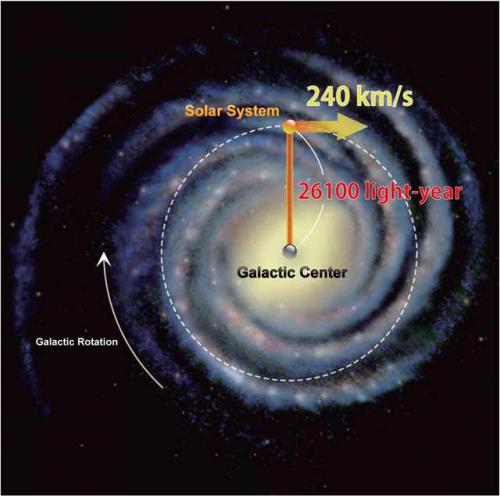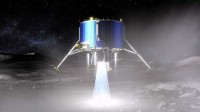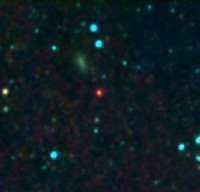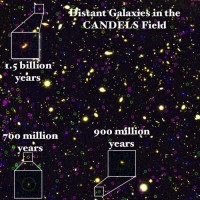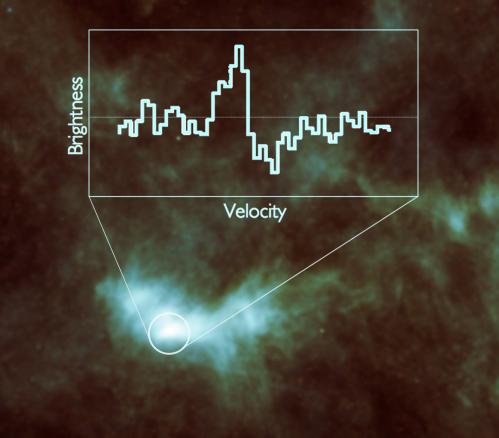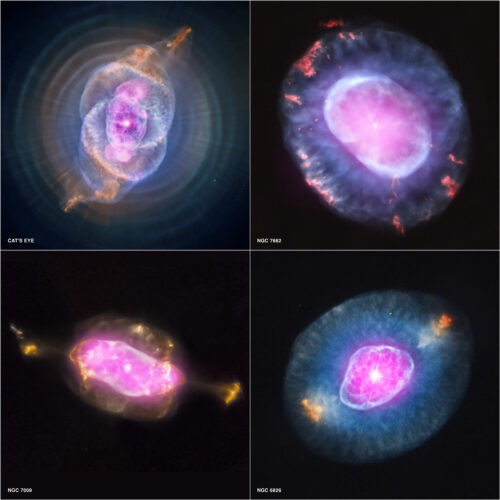W&T Wetenschap & Technologie
Een plek om te discussiŰren over wetenschappelijke onderwerpen, wetenschappelijke problemen, technologische projecten en grootse uitvindingen.



Armpjes strekken
<a href="http://www.vwkweb.nl/" rel="nofollow" target="_blank">Vereniging voor weerkunde en klimatologie</a>
<a href="http://www.estofex.org/" rel="nofollow" target="_blank">ESTOFEX</a>
<a href="http://www.estofex.org/" rel="nofollow" target="_blank">ESTOFEX</a>


De zon’s positie in de Melkweg preciezer dan ooit gemeten
Een Japans team van astronomen heeft de positie van de zon in de Melkweg heel precies gemeten. Hieruit blijkt dat afstand tussen de zon en het centrum van de Melkweg 26.100 lichtjaar bedraagt en dat de zon met een snelheid van 240 km/s rondom het galactische centrum draait. Voorgaande schattingen gingen uit van een snelheid van 220 km/s. Deze hogere snelheid kan alleen verklaard worden als de massa van de Melkweg 20% hoger is dan gedacht.
Lees het volledige artikel op AstroBlogs
Een Japans team van astronomen heeft de positie van de zon in de Melkweg heel precies gemeten. Hieruit blijkt dat afstand tussen de zon en het centrum van de Melkweg 26.100 lichtjaar bedraagt en dat de zon met een snelheid van 240 km/s rondom het galactische centrum draait. Voorgaande schattingen gingen uit van een snelheid van 220 km/s. Deze hogere snelheid kan alleen verklaard worden als de massa van de Melkweg 20% hoger is dan gedacht.
Lees het volledige artikel op AstroBlogs


Europa en Rusland willen samen naar de maan
Europa en Rusland gaan samenwerken aan een onbemande maanmissie, met als doel om in 2020 of 2022 bevroren bodemmonsters terug naar de aarde te brengen. De missie wordt Lunar Polar Sample Return (LPSR) genoemd en zal gaan boren in de noord- of zuidpool van de maan, om meer te weten te komen over de samenstelling van de maanbodem. Ze willen vooral weten hoeveel vluchtige stoffen (zoals water) de maanbodem bevat.
Lees het volledige artikel op AstroBlogs
Europa en Rusland gaan samenwerken aan een onbemande maanmissie, met als doel om in 2020 of 2022 bevroren bodemmonsters terug naar de aarde te brengen. De missie wordt Lunar Polar Sample Return (LPSR) genoemd en zal gaan boren in de noord- of zuidpool van de maan, om meer te weten te komen over de samenstelling van de maanbodem. Ze willen vooral weten hoeveel vluchtige stoffen (zoals water) de maanbodem bevat.
Lees het volledige artikel op AstroBlogs


Zwart gat van onvoorstelbare proporties ontdekt
Astronomen hebben een nieuwe populatie van enorme, snelgroeiende zwarte gaten ontdekt. De zwarte gaten zijn niet eerder ontdekt doordat ze omringd worden door dikke stofwolken, waardoor ze alleen met infraroodinstrumenten waarneembaar zijn. De ontdekking is verricht in het kader van een ongeŰvenaarde infraroodstudie van de hemel. Het meest extreme object in de studie is een supermassief zwart gat dat door het leven gaat als ULASJ1234+0907. Dit object is het allerzwaarste zwarte gat dat ooit is waargenomen. Het object bevindt zich op een dusdanige grote afstand, dat het licht er 11 miljard jaar over heeft gedaan om ons te bereiken, waardoor we het zwarte gat zien zoals het er in het verre verleden uitzag. Dit monsterlijke zwarte gat weegt evenveel als 10 miljard zonnen en is daarmee 10.000 keer zwaarder dan het supermassieve zwarte gat in de kern van ons eigen melkwegstelsel.
Lees het volledige artikel op AstroBlogs
Astronomen hebben een nieuwe populatie van enorme, snelgroeiende zwarte gaten ontdekt. De zwarte gaten zijn niet eerder ontdekt doordat ze omringd worden door dikke stofwolken, waardoor ze alleen met infraroodinstrumenten waarneembaar zijn. De ontdekking is verricht in het kader van een ongeŰvenaarde infraroodstudie van de hemel. Het meest extreme object in de studie is een supermassief zwart gat dat door het leven gaat als ULASJ1234+0907. Dit object is het allerzwaarste zwarte gat dat ooit is waargenomen. Het object bevindt zich op een dusdanige grote afstand, dat het licht er 11 miljard jaar over heeft gedaan om ons te bereiken, waardoor we het zwarte gat zien zoals het er in het verre verleden uitzag. Dit monsterlijke zwarte gat weegt evenveel als 10 miljard zonnen en is daarmee 10.000 keer zwaarder dan het supermassieve zwarte gat in de kern van ons eigen melkwegstelsel.
Lees het volledige artikel op AstroBlogs


Hmmm dit gaat nog is ergens over,.
Zwart gat in kaart gebracht
http://www.space.com/8372(...)nded-scientists.html
Dark flow,....
Zwart gat in kaart gebracht
http://www.space.com/8372(...)nded-scientists.html
Dark flow,....
signature


Sterrenstelsels werden al snel stoffig
In het dagelijks leven kan stof behoorlijk hinderlijk zijn. Toch vormt stof een belangrijke bouwsteen voor sterren en planeten. Astronomen willen dan ook graag weten hoe kosmisch stof precies ontstaat. Deze kennis vormt een integraal onderdeel van ons begrip van sterrenstelsels, sterren en planeten. Hiertoe is een team van astronomen begonnen met een grootschalig onderzoek naar de geschiedenis van kosmisch stof, waarbij ze gebruik maken van waarnemingen die verricht zijn met de Hubble Space Telescope.
Lees het volledige artikel op AstroBlogs
In het dagelijks leven kan stof behoorlijk hinderlijk zijn. Toch vormt stof een belangrijke bouwsteen voor sterren en planeten. Astronomen willen dan ook graag weten hoe kosmisch stof precies ontstaat. Deze kennis vormt een integraal onderdeel van ons begrip van sterrenstelsels, sterren en planeten. Hiertoe is een team van astronomen begonnen met een grootschalig onderzoek naar de geschiedenis van kosmisch stof, waarbij ze gebruik maken van waarnemingen die verricht zijn met de Hubble Space Telescope.
Lees het volledige artikel op AstroBlogs


Enorme hoeveelheid water ontdekt in stervormende nevel
Met behulp van de Europese Herschel-ruimtetelscoop zijn grote hoeveelheden waterdamp ontdekt in een koude gaswolk in het sterrenbeeld Stier. De hoeveelheid waterdamp is groot genoeg om de aardse oceanen 2000 keer te vullen. De aanwezigheid van zoveel waterdamp wijst op een nog veel grotere voorraad waterijs in de gaswolk, genoeg voor een paar miljoen bevroren oceanen op aarde.
Lees het volledige artikel op AstroBlogs
Met behulp van de Europese Herschel-ruimtetelscoop zijn grote hoeveelheden waterdamp ontdekt in een koude gaswolk in het sterrenbeeld Stier. De hoeveelheid waterdamp is groot genoeg om de aardse oceanen 2000 keer te vullen. De aanwezigheid van zoveel waterdamp wijst op een nog veel grotere voorraad waterijs in de gaswolk, genoeg voor een paar miljoen bevroren oceanen op aarde.
Lees het volledige artikel op AstroBlogs


Uuuh....die link heeft niets met zwarte gaten te maken....en ook niet met de dark flowquote:Op dinsdag 9 oktober 2012 21:14 schreef sunlost het volgende:
Hmmm dit gaat nog is ergens over,.
Zwart gat in kaart gebracht
http://www.space.com/8372(...)nded-scientists.html
Dark flow,....


10-10-2012
Astronomen ontdekken onverwachte structuur in materiaal rond oude ster
Met behulp van de ALMA-radiotelescoop hebben astronomen een totaal onverwachte spiraalstructuur ontdekt in het materiaal rond een oude ster. Dat heeft de Europese Zuidelijke Sterrenwacht ESO bekendgemaakt. M.A.T. Groenewegen van de Koninklijke Belgische Sterrenwacht maakt deel uit van het team.
In het gas rond de rode reuzenster R Sculptoris stootten de onderzoekers met de krachtige radiotelescoop verrassend op een spiraalstructuur. Het is de eerste keer dat rond een stervende ster zowel een bolvormige buitenschil als een daarbinnen gelegen spiraalstructuur is ontdekt.
Het is ook voor het eerst dat astronomen zo'n spiraal ruimtelijk in kaart konden brengen. De vreemde vorm is waarschijnlijk ontstaan doordat een (niet-waarneembare) begeleidende ster om de rode reus cirkelt, vermoedt de ESO.
De astronomen ontdekten tot hun verrassing ook dat de rode reus onverwacht veel materiaal heeft uitgestoten. Omdat ze grote hoeveelheden materiaal uitstoten, dragen rode reuzen als R Sculptoris belangrijk bij aan het stof en gas dat het leeuwendeel vormt van het ruwe materiaal waaruit toekomstige generaties van sterren, planetenstelsels en uiteindelijk ook leven ontstaan, beklemtoont de ESO.
(HLN)
Astronomen ontdekken onverwachte structuur in materiaal rond oude ster
Met behulp van de ALMA-radiotelescoop hebben astronomen een totaal onverwachte spiraalstructuur ontdekt in het materiaal rond een oude ster. Dat heeft de Europese Zuidelijke Sterrenwacht ESO bekendgemaakt. M.A.T. Groenewegen van de Koninklijke Belgische Sterrenwacht maakt deel uit van het team.
In het gas rond de rode reuzenster R Sculptoris stootten de onderzoekers met de krachtige radiotelescoop verrassend op een spiraalstructuur. Het is de eerste keer dat rond een stervende ster zowel een bolvormige buitenschil als een daarbinnen gelegen spiraalstructuur is ontdekt.
Het is ook voor het eerst dat astronomen zo'n spiraal ruimtelijk in kaart konden brengen. De vreemde vorm is waarschijnlijk ontstaan doordat een (niet-waarneembare) begeleidende ster om de rode reus cirkelt, vermoedt de ESO.
De astronomen ontdekten tot hun verrassing ook dat de rode reus onverwacht veel materiaal heeft uitgestoten. Omdat ze grote hoeveelheden materiaal uitstoten, dragen rode reuzen als R Sculptoris belangrijk bij aan het stof en gas dat het leeuwendeel vormt van het ruwe materiaal waaruit toekomstige generaties van sterren, planetenstelsels en uiteindelijk ook leven ontstaan, beklemtoont de ESO.
(HLN)
Death Makes Angels of us all
And gives us wings where we had shoulders
Smooth as raven' s claws...
And gives us wings where we had shoulders
Smooth as raven' s claws...


08-10-2012
Europa en Rusland willen samen naar de maan
Europa en Rusland werken samen aan een onbemande ruimtemissie die in 2020 of 2022 bevroren bodemmonsters bij de noord- of zuidpool van de maan moet ophalen. Doel van de missie Lunar Polar Sample Return (LPSR) is om meer inzicht te krijgen in de samenstelling van die bodem.
Er bestaan sterke aanwijzingen dat er in diepe kraters rond de polen van de maan bevroren water te vinden is. De bodems van deze kraters zijn in eeuwige duisternis gehuld en daardoor zˇ koud dat water dat er ooit belandt bijna niet kan verdampen. Idealiter zou zo'n donkere kraterbodem dus dÚ plek zijn voor nader onderzoek, maar dat is met de huidige technologie niet haalbaar.
Daarom is ervoor gekozen om de LPSR-sonde in vrijwel permanent door de zon verlichte maanbodem te laten boren. Door de boormonsters onmiddellijk tot een temperatuur van meer dan 100 graden onder nul af te koelen, hopen wetenschappers meer te weten te komen over de aanwezigheid van vluchtige stoffen op de maan. (EE)
(allesoversterrenkunde)
Europa en Rusland willen samen naar de maan
Europa en Rusland werken samen aan een onbemande ruimtemissie die in 2020 of 2022 bevroren bodemmonsters bij de noord- of zuidpool van de maan moet ophalen. Doel van de missie Lunar Polar Sample Return (LPSR) is om meer inzicht te krijgen in de samenstelling van die bodem.
Er bestaan sterke aanwijzingen dat er in diepe kraters rond de polen van de maan bevroren water te vinden is. De bodems van deze kraters zijn in eeuwige duisternis gehuld en daardoor zˇ koud dat water dat er ooit belandt bijna niet kan verdampen. Idealiter zou zo'n donkere kraterbodem dus dÚ plek zijn voor nader onderzoek, maar dat is met de huidige technologie niet haalbaar.
Daarom is ervoor gekozen om de LPSR-sonde in vrijwel permanent door de zon verlichte maanbodem te laten boren. Door de boormonsters onmiddellijk tot een temperatuur van meer dan 100 graden onder nul af te koelen, hopen wetenschappers meer te weten te komen over de aanwezigheid van vluchtige stoffen op de maan. (EE)
(allesoversterrenkunde)
Death Makes Angels of us all
And gives us wings where we had shoulders
Smooth as raven' s claws...
And gives us wings where we had shoulders
Smooth as raven' s claws...


09-10-2012
Infraroodsatelliet ontdekt enorme hoeveelheid water
De Europese infraroodsatelliet Herschel heeft ontdekt dat een gaswolk in het sterrenbeeld Stier zeer veel waterdamp bevat. Met de waargenomen hoeveelheid waterdamp kunnen alle oceanen op aarde tweeduizend keer worden gevuld. Daarnaast bevat de gaswolk waarschijnlijk een nog veel grotere hoeveelheid bevroren water.
De zeer koude gaswolk, Lynds 1544 geheten, maakt deel uit van een grote stellaire kraamkamer. Hij staat min of meer op het punt om samen te trekken tot wat uiteindelijk een nieuwe ster zal zijn. Het is voor het eerst dat er in zo'n 'pre-stellaire kern' waterdamp is waargenomen.
Een wolk als deze bestaat niet alleen uit gas, maar bevat ook grote hoeveelheden stofdeeltjes die in een manteltje van ijs zijn gehuld. De door Herschel waargenomen waterdamp is waarschijnlijk vrijgekomen door de inwerking van energierijke kosmische straling op dat ijzige stof.
Dat betekent dat gedetecteerde waterdamp slechts het topje van de ijsberg moet zijn. Geschat wordt dat Lynds 1544 meer dan drie miljoen keer zoveel (bevroren) water bevat als alle oceanen op onze planeet bij elkaar. De Herschel-waarnemingen laten zien dat de watermoleculen naar het hart van de gaswolk stromen, de plek waar zich uiteindelijk een nieuwe ster, en waarschijnlijk ook een nieuw planetenstelsel zal vormen. (EE)
(allesoversterrenkunde)
Infraroodsatelliet ontdekt enorme hoeveelheid water
De Europese infraroodsatelliet Herschel heeft ontdekt dat een gaswolk in het sterrenbeeld Stier zeer veel waterdamp bevat. Met de waargenomen hoeveelheid waterdamp kunnen alle oceanen op aarde tweeduizend keer worden gevuld. Daarnaast bevat de gaswolk waarschijnlijk een nog veel grotere hoeveelheid bevroren water.
De zeer koude gaswolk, Lynds 1544 geheten, maakt deel uit van een grote stellaire kraamkamer. Hij staat min of meer op het punt om samen te trekken tot wat uiteindelijk een nieuwe ster zal zijn. Het is voor het eerst dat er in zo'n 'pre-stellaire kern' waterdamp is waargenomen.
Een wolk als deze bestaat niet alleen uit gas, maar bevat ook grote hoeveelheden stofdeeltjes die in een manteltje van ijs zijn gehuld. De door Herschel waargenomen waterdamp is waarschijnlijk vrijgekomen door de inwerking van energierijke kosmische straling op dat ijzige stof.
Dat betekent dat gedetecteerde waterdamp slechts het topje van de ijsberg moet zijn. Geschat wordt dat Lynds 1544 meer dan drie miljoen keer zoveel (bevroren) water bevat als alle oceanen op onze planeet bij elkaar. De Herschel-waarnemingen laten zien dat de watermoleculen naar het hart van de gaswolk stromen, de plek waar zich uiteindelijk een nieuwe ster, en waarschijnlijk ook een nieuw planetenstelsel zal vormen. (EE)
(allesoversterrenkunde)
Death Makes Angels of us all
And gives us wings where we had shoulders
Smooth as raven' s claws...
And gives us wings where we had shoulders
Smooth as raven' s claws...


R÷ntgensatelliet Chandra bestudeert planetaire nevels
De laatste stuiptrekkingen van stervende sterren vormen het mikpunt van een uitgebreid r÷ntgenonderzoek,waarbij gebruik wordt gemaakt van de Amerikaanse ruimtetelescoop Chandra X-Ray Observatory. Hiermee heeft men waarnemingen verricht van twintig nabije planetaire nevels. Het onderzoek moet meer inzicht verschaffen in de laatste levensjaren van zonachtige sterren.
Sterren sterven niet allemaal op dezelfde manier. Massieve sterren sterven door middel van een spectaculaire explosie: een zogenaamde supernova. Bij de meeste sterren wordt de laatste adem echter op een rustiger manier uitgeblazen. Zonachtige sterren evolueren aan het eind van hun leven tot een zogenaamde Rode Reus. Na verloop van tijd zorgen allerlei inwendige processen ervoor dat de Rode Reus zijn buitenste lagen gaat afstoten. Hierdoor wordt de naakte, hete kern (de zogenaamde Witte Dwerg) blootgelegd.
De straling van de kern doet de afgestoten luchtlagen oplichten, terwijl de sterrenwind die afkomstig is van de witte dwerg de afgestoten luchtlagen doet boetseren in de meest wonderlijke vormen. Het resultaat is een zogenaamde planetaire nevel. De naam is wat ongelukkig gekozen: planetaire nevels hebben immers niets met planeten van doen. De reden is als volgt: gezien door de relatief primitieve telescopen uit de 19de eeuw leken dit soort nevels op de schijven van planeten.
Lees het volledige artikel op AstroBlogs
De laatste stuiptrekkingen van stervende sterren vormen het mikpunt van een uitgebreid r÷ntgenonderzoek,waarbij gebruik wordt gemaakt van de Amerikaanse ruimtetelescoop Chandra X-Ray Observatory. Hiermee heeft men waarnemingen verricht van twintig nabije planetaire nevels. Het onderzoek moet meer inzicht verschaffen in de laatste levensjaren van zonachtige sterren.
Sterren sterven niet allemaal op dezelfde manier. Massieve sterren sterven door middel van een spectaculaire explosie: een zogenaamde supernova. Bij de meeste sterren wordt de laatste adem echter op een rustiger manier uitgeblazen. Zonachtige sterren evolueren aan het eind van hun leven tot een zogenaamde Rode Reus. Na verloop van tijd zorgen allerlei inwendige processen ervoor dat de Rode Reus zijn buitenste lagen gaat afstoten. Hierdoor wordt de naakte, hete kern (de zogenaamde Witte Dwerg) blootgelegd.
De straling van de kern doet de afgestoten luchtlagen oplichten, terwijl de sterrenwind die afkomstig is van de witte dwerg de afgestoten luchtlagen doet boetseren in de meest wonderlijke vormen. Het resultaat is een zogenaamde planetaire nevel. De naam is wat ongelukkig gekozen: planetaire nevels hebben immers niets met planeten van doen. De reden is als volgt: gezien door de relatief primitieve telescopen uit de 19de eeuw leken dit soort nevels op de schijven van planeten.
Lees het volledige artikel op AstroBlogs


‘Rotsachtige’ superaarde blijkt diamantplaneet te zijn
Nieuw onderzoek heeft uitgewezen dat een verre rotsachtige super-aarde eigenlijk een diamantplaneet is. Het is voor het eerst dat een rotswereld met een fundamenteel andere samenstelling dan de aarde is gevonden. Het oppervlak van de planeet is vermoedelijk bedekt met grafiet en diamant in plaats van graniet en water.
De planeet in kwestie, 55 Cancri e, is twee keer zo groot als de aarde en heeft een acht keer grotere massa, waardoor het tot de zogenaamde “super-aardes” wordt gerekend. De planeet behoort tot een stelsel van vijf planeten die draaien rond de zonachtige ster 55 Cancri, die zich op een afstand van 40 lichtjaar van de aarde bevindt, in de richting van het sterrenbeeld Kreeft.
Lees het volledige artikel op AstroBlogs
Nieuw onderzoek heeft uitgewezen dat een verre rotsachtige super-aarde eigenlijk een diamantplaneet is. Het is voor het eerst dat een rotswereld met een fundamenteel andere samenstelling dan de aarde is gevonden. Het oppervlak van de planeet is vermoedelijk bedekt met grafiet en diamant in plaats van graniet en water.
De planeet in kwestie, 55 Cancri e, is twee keer zo groot als de aarde en heeft een acht keer grotere massa, waardoor het tot de zogenaamde “super-aardes” wordt gerekend. De planeet behoort tot een stelsel van vijf planeten die draaien rond de zonachtige ster 55 Cancri, die zich op een afstand van 40 lichtjaar van de aarde bevindt, in de richting van het sterrenbeeld Kreeft.
Lees het volledige artikel op AstroBlogs


Astero´de scheert morgen vlak langs de aarde
De pas ontdekte astero´de 2012 TC4 scheert vannacht langs de aarde en komt daarbij dichterbij dan de maan. Wanneer de astero´de het dichtst bij de aarde is, is de afstand tussen ons en 2012 TC4 zo’n 96.000 kilometer.
Toch vormt de astero´de geen enkele reden tot zorg. Een botsing met de aarde is namelijk uitgesloten.
2012 TC4 werd onlangs ontdekt. De astero´de is ongeveer 16 meter groot en is vrij helder. NASA houdt de astero´de ondanks dat deze geen gevaar vormt toch goed in de gaten. De ruimtevaartorganisatie wil de exacte baan van de astero´de graag achterhalen en zou ook graag te weten komen hoe groot de astero´de precies is.
Het komt regelmatig voor dat astero´den relatief dicht bij de aarde in de buurt komen. In september scheerden nog twee astero´den langs onze planeet. EÚn ervan had een doorsnede van ÚÚn kilometer. De ander had een doorsnee van 190 tot 430 meter. Beide astero´den kwamen echter niet zo dichtbij als 2012 TC4: de afstand tussen de aarde en de astero´den bedroeg respectievelijk 8,7 miljoen en 2,8 miljoen kilometer.
(scientias.nl)
De pas ontdekte astero´de 2012 TC4 scheert vannacht langs de aarde en komt daarbij dichterbij dan de maan. Wanneer de astero´de het dichtst bij de aarde is, is de afstand tussen ons en 2012 TC4 zo’n 96.000 kilometer.
Toch vormt de astero´de geen enkele reden tot zorg. Een botsing met de aarde is namelijk uitgesloten.
2012 TC4 werd onlangs ontdekt. De astero´de is ongeveer 16 meter groot en is vrij helder. NASA houdt de astero´de ondanks dat deze geen gevaar vormt toch goed in de gaten. De ruimtevaartorganisatie wil de exacte baan van de astero´de graag achterhalen en zou ook graag te weten komen hoe groot de astero´de precies is.
Het komt regelmatig voor dat astero´den relatief dicht bij de aarde in de buurt komen. In september scheerden nog twee astero´den langs onze planeet. EÚn ervan had een doorsnede van ÚÚn kilometer. De ander had een doorsnee van 190 tot 430 meter. Beide astero´den kwamen echter niet zo dichtbij als 2012 TC4: de afstand tussen de aarde en de astero´den bedroeg respectievelijk 8,7 miljoen en 2,8 miljoen kilometer.
(scientias.nl)


Close encounters #2: Asteroiden scheren langs de aardequote:Op donderdag 11 oktober 2012 19:02 schreef Robus het volgende:
Astero´de scheert morgen vlak langs de aarde
<a href="http://www.vwkweb.nl/" rel="nofollow" target="_blank">Vereniging voor weerkunde en klimatologie</a>
<a href="http://www.estofex.org/" rel="nofollow" target="_blank">ESTOFEX</a>
<a href="http://www.estofex.org/" rel="nofollow" target="_blank">ESTOFEX</a>


Ik ben van plan om binnenkort een telescoop aan te schaffen. Kan iemand mij een goede telescoop aanraden + leverancier? Budget is max 400 euro. 
Burning bridges gives you so much more


als ik jou was zou ik een op astroforum.nl gaan kijken, daar zitten mensen die echt al jarenlang met telescopen bezig zijn en je goed advies kunnen geven, in het beginnersforum vindt je ook nog een hoop topics over eerste telescoopaanschaffen:quote:Op zaterdag 13 oktober 2012 02:28 schreef Gatenkaas het volgende:
Ik ben van plan om binnenkort een telescoop aan te schaffen. Kan iemand mij een goede telescoop aanraden + leverancier? Budget is max 400 euro.
http://www.astroforum.nl/forumdisplay.php/332-Beginnersforum
ligt voornamelijk eraan waarvoor je je telescoop wilt gebruiken, maar iets als dit zou al heel fijn speelgoed zijn
http://www.robtics.nl/pro(...)363&products_id=1625
<hr>


http://www.nytimes.com/20(...)a-centauri.html?_r=0quote:Bringing the search for another Earth about as close as it will ever get, a team of European astronomers was scheduled to announce on Wednesday that it had found a planet the same mass as Earth’s in Alpha Centauri, a triple star system that is the Sun’s closest neighbor, only 4.4 light-years away.
The planet is the lightest one ever found orbiting another star and — in the words of its discoverer, Xavier Dumusque, a graduate student at the Geneva Observatory — “it will surely be the closest one ever.”
It is presumably a rocky ball like our own, but it is not habitable. It circles Alpha Centauri B, a reddish orb about half as luminous as the Sun, every three days at a distance of only about four million miles, resulting in hellish surface temperatures of 1,200 degrees.
So this is not “Earth 2.0.” Yet.
Astronomers said the discovery raised the possibility that there were habitable Earthlike planets right next door and that methods and instruments were now precise enough to detect them.
“Very small planets are not rare,” said Mr. Dumusque, who is the lead author of a paper being published on Wednesday in Nature. “When you find one small planet, you find others.” He and his colleagues discussed the results on Tuesday in a news conference hosted by the European Southern Observatory in Garching, Germany.
Astronomers were electrified by the news of the planet, but also cautioned that it needed confirmation by other astronomers, not an easy task.
Debra Fischer, a Yale astronomer who has been searching for planets in that same system for years, said: “The discovery that our nearest neighbor has rocky planets is the story of the decade. I’d bet $100 that there are other planets that are there as well.”
The discovery also underscored the allure of Alpha Centauri as a target of space and scientific exploration.
“This is close enough you can almost spit there,” said Geoffrey Marcy, an exoplanet astronomer at the University of California, Berkeley.
Sara Seager, an astronomer at the Massachusetts Institute of Technology, said in an e-mail, “I feel like we should drop everything and send a probe there to study the new planet and others that are likely in the system.”
There are three stars in that system. Alpha Centauri A, which is slightly larger and brighter than the Sun, and Alpha Centauri B, slightly smaller, are close companions, circling each other and passing as close as nine billion miles every 80 years. They in turn are being circled at a much greater distance, some one trillion miles, by a dwarf star that is known as Proxima Centauri because it is slightly closer to the Earth, due to that trillion miles, than the other two.
The so-called habitable zone of Alpha Centauri B, where temperatures would be moderate enough for water and creatures like us, is about 65 million miles from the star, where a year would take 200 days or so, about the same as the orbit of Venus in our own system.
Mr. Dumusque and his colleagues found the planet by the so-called wobble method, using a specially built spectrograph called HARPS on a 140-inch diameter telescope at the European Southern Observatory in La Silla, Chile, to track the host star as it is tugged to and fro by the planet’s gravity. After four years and 450 observations, they found that in the case of Alpha Centauri B, that tug imparts a velocity of about 20 inches a second, a leisurely walking speed.
That is the smallest wobble the Swiss team has ever observed.
A planet only four times as massive as the Earth would produce the same amount of wobble if it was out in the habitable zone and would thus be detectable by their instrument, Mr. Dumusque said. But it would take a long time. “If you want to find a planet at 200 days,” he said referring to the orbital period, “you need 8 to 10 years.”
Dr. Marcy said this was the kind of discovery that could reignite interest in other experiments like the Terrestrial Planet Finder, a space observatory for studying exoplanets that was once at the top of NASA’s wish list but is now languishing.
Two years ago, Dr. Marcy startled his colleagues at an M.I.T. symposium with a bitter criticism of NASA, the National Academy of Sciences and the planetary community itself for failing to define and sell advanced exoplanet missions. He went on to call for an international project to launch a scientific probe to Alpha Centauri.
It could take hundreds of years, but such a mission, Dr. Marcy said, could jolt NASA out of its doldrums.
The new planet, Dr. Marcy said, “fits right into that rant.” He went on, “What a great scientific educational mission to have a probe out there, making its way decade after decade.”


'Maan ontstond uit botsing aarde en planeet'
AMSTERDAM - De samenstelling van zink in de maan vormt bewijs dat de maan ontstaan is tijdens een indrukwekkende botsing tussen de aarde en een onbekende planeet met de grootte van Mars.
Dat schrijven onderzoekers van de Universiteit van Washington en het Amerikaanse Scripps Instituut voor Oceanografie vandaag in Nature.
De onderzoekers bekeken stukken steen afkomstig van twintig verschillende plekken op de maan. Bijvoorbeeld basalt, gestolde magma uit het binnenste van de maan. Ze keken naar de verhouding tussen twee varianten -isotopen- van het element zink: een lichte variant en een zwaardere variant.
Maanstenen bleken veel minder zink te bevatten dan stenen van aarde of Mars. En het zink dßt de wetenschappers vonden, was in alle maanstenen relatief vaak van de zware variant en relatief zelden van de lichte variant. De zinkverhoudingen in stenen van aarde en ook van Mars waren net even anders.
Belangrijk
Het verschil is klein, maar belangrijk. Volgens de onderzoekers is dit bewijs voor een theorie over het ontstaan van de maan die al dertig jaar bestaat, maar nooit hard gemaakt kon worden.
Die theorie is dat onze maan ontstond toen een planeet ter grootte van Mars op een oerversie van de aarde knalde. Er kwam zoveel energie vrij bij deze botsing, dat de onbekende planeet in zijn geheel smolt en verdampte, net als een groot deel van de gesteenten van aarde. Daarmee verdampten ook de stoffen in die gesteenten, zoals zink.
De maan zou ontstaan zijn toen een wolk gesmolten steen, gas en puin weer samenklonterde.
In theorie zouden de lichte varianten van stoffen als zink sneller moeten verdampen dan de zware varianten.
De lichte isotopen zouden dan verdwijnen in de lucht. De zware varianten zouden juist iets moeilijker verdampen en eerder weer condenseren. Zij zouden daarom eerder terecht komen in het gesmolten en later gestolde gesteente.
Na een botsing tussen aarde en een andere planeet zouden er dus meer zware isotopen dan lichte isotopen terug te vinden moeten zijn in maansteen.
Aangepast
Tot nu toe kon niemand echter zo’n vreemde verhouding van isotopen ontdekken in maansteen. Sterker nog: de samenstelling van de aarde en die van de maan leken tot nu toe zo akelig veel op elkaar, dat de theorie over hoe de maan ontstaan moet zijn recentelijk werd aangepast.
De Amerikaanse wetenschappers vonden dan eindelijk toch zulke afwijkende verhoudingen, bij zink.
Bron: http://www.nu.nl/wetensch(...)arde-en-planeet.html
AMSTERDAM - De samenstelling van zink in de maan vormt bewijs dat de maan ontstaan is tijdens een indrukwekkende botsing tussen de aarde en een onbekende planeet met de grootte van Mars.
Dat schrijven onderzoekers van de Universiteit van Washington en het Amerikaanse Scripps Instituut voor Oceanografie vandaag in Nature.
De onderzoekers bekeken stukken steen afkomstig van twintig verschillende plekken op de maan. Bijvoorbeeld basalt, gestolde magma uit het binnenste van de maan. Ze keken naar de verhouding tussen twee varianten -isotopen- van het element zink: een lichte variant en een zwaardere variant.
Maanstenen bleken veel minder zink te bevatten dan stenen van aarde of Mars. En het zink dßt de wetenschappers vonden, was in alle maanstenen relatief vaak van de zware variant en relatief zelden van de lichte variant. De zinkverhoudingen in stenen van aarde en ook van Mars waren net even anders.
Belangrijk
Het verschil is klein, maar belangrijk. Volgens de onderzoekers is dit bewijs voor een theorie over het ontstaan van de maan die al dertig jaar bestaat, maar nooit hard gemaakt kon worden.
Die theorie is dat onze maan ontstond toen een planeet ter grootte van Mars op een oerversie van de aarde knalde. Er kwam zoveel energie vrij bij deze botsing, dat de onbekende planeet in zijn geheel smolt en verdampte, net als een groot deel van de gesteenten van aarde. Daarmee verdampten ook de stoffen in die gesteenten, zoals zink.
De maan zou ontstaan zijn toen een wolk gesmolten steen, gas en puin weer samenklonterde.
In theorie zouden de lichte varianten van stoffen als zink sneller moeten verdampen dan de zware varianten.
De lichte isotopen zouden dan verdwijnen in de lucht. De zware varianten zouden juist iets moeilijker verdampen en eerder weer condenseren. Zij zouden daarom eerder terecht komen in het gesmolten en later gestolde gesteente.
Na een botsing tussen aarde en een andere planeet zouden er dus meer zware isotopen dan lichte isotopen terug te vinden moeten zijn in maansteen.
Aangepast
Tot nu toe kon niemand echter zo’n vreemde verhouding van isotopen ontdekken in maansteen. Sterker nog: de samenstelling van de aarde en die van de maan leken tot nu toe zo akelig veel op elkaar, dat de theorie over hoe de maan ontstaan moet zijn recentelijk werd aangepast.
De Amerikaanse wetenschappers vonden dan eindelijk toch zulke afwijkende verhoudingen, bij zink.
Bron: http://www.nu.nl/wetensch(...)arde-en-planeet.html
Herman Finkers... He buurman, ik hier ?


18-10-2012
Onderzoek bevestigt theorie: Maan is uit Aarde ontstaan
ę ap.
De Maan is inderdaad samengesmolten uit stukjes verpulverde planeet die 4,5 miljard jaar door een catastrofale botsing de ruimte zijn ingeslingerd, zo stellen volgens website space.com twee nieuwe studies.
Volgens vroegere versies van de theorie is de Maan primair ontstaan uit brokstukken van een mysterieus Mars-achtig hemellichaam dat tegen de proto-Aarde is geknald. Maar die theorie mankelt wat omdat Aarde en Maan uit hetzelfde materiaal zijn gemaakt, zegt space.com. Nu zijn er twee nieuwe, zij het lichtjes van elkaar afwijkende, modellen die uitleggen hoe beiden geologische tweelingzusters werden.
Materiaal uitspuwen
Matija Cuk van de Zoektocht naar Buitenaards Leven (SETI) en Sarah Stewart van de Harvard-universiteit zoeken het antwoord in de rotatie van de Aarde. Indien een dag op het ogenblik van de botsing slechts twee of drie uur zou hebben geduurd, zou onze planeet voldoende materiaal hebben uitgespuwd om onze natuurlijke satelliet te doen ontstaan. Die heeft immers slechts 1,2 keer de massa van de Aarde.
Die rotatiesnelheid lijkt ongelooflijk hoog, dichtbij de grens waarop de planeet uiteen zou vallen. Maar volgens Cuk en Stewart was het vroege zonnestelsel een "schiettent" met talrijke grote botsingen die planeten tot enorme rotatiesnelheden kunnen hebben aangezet. Na de botsing kan gravitationele interactie tussen Aarde en op de rem hebben getrapt en voor de dag van 24 uur hebben gezorgd.
Gewichtsklasse
Robin Canup van het Southwest Research Institute in Boulder opperde van haar kant een botsing van twee hemellichamen van dezelfde gewichtsklasse, ongeveer 50 procent van de huidige massa van de Aarde. Zo'n botsing is trouwens al naar voren geschoven om de vorming van de Plutomaan Charon te verklaren.
In de computermodellen van Canup heeft de symmetrie van de impact de schijf van brokstukken doen ontstaan waaruit de Maan zich heeft gevormd. Die schijf was nagenoeg identiek aan de mantel van de toen pas vergrote Aarde. Ook in deze theorie moet de rotatie van de Aarde trouwens aardig zijn toegenomen.
(HLN)
Onderzoek bevestigt theorie: Maan is uit Aarde ontstaan
ę ap.
De Maan is inderdaad samengesmolten uit stukjes verpulverde planeet die 4,5 miljard jaar door een catastrofale botsing de ruimte zijn ingeslingerd, zo stellen volgens website space.com twee nieuwe studies.
Volgens vroegere versies van de theorie is de Maan primair ontstaan uit brokstukken van een mysterieus Mars-achtig hemellichaam dat tegen de proto-Aarde is geknald. Maar die theorie mankelt wat omdat Aarde en Maan uit hetzelfde materiaal zijn gemaakt, zegt space.com. Nu zijn er twee nieuwe, zij het lichtjes van elkaar afwijkende, modellen die uitleggen hoe beiden geologische tweelingzusters werden.
Materiaal uitspuwen
Matija Cuk van de Zoektocht naar Buitenaards Leven (SETI) en Sarah Stewart van de Harvard-universiteit zoeken het antwoord in de rotatie van de Aarde. Indien een dag op het ogenblik van de botsing slechts twee of drie uur zou hebben geduurd, zou onze planeet voldoende materiaal hebben uitgespuwd om onze natuurlijke satelliet te doen ontstaan. Die heeft immers slechts 1,2 keer de massa van de Aarde.
Die rotatiesnelheid lijkt ongelooflijk hoog, dichtbij de grens waarop de planeet uiteen zou vallen. Maar volgens Cuk en Stewart was het vroege zonnestelsel een "schiettent" met talrijke grote botsingen die planeten tot enorme rotatiesnelheden kunnen hebben aangezet. Na de botsing kan gravitationele interactie tussen Aarde en op de rem hebben getrapt en voor de dag van 24 uur hebben gezorgd.
Gewichtsklasse
Robin Canup van het Southwest Research Institute in Boulder opperde van haar kant een botsing van twee hemellichamen van dezelfde gewichtsklasse, ongeveer 50 procent van de huidige massa van de Aarde. Zo'n botsing is trouwens al naar voren geschoven om de vorming van de Plutomaan Charon te verklaren.
In de computermodellen van Canup heeft de symmetrie van de impact de schijf van brokstukken doen ontstaan waaruit de Maan zich heeft gevormd. Die schijf was nagenoeg identiek aan de mantel van de toen pas vergrote Aarde. Ook in deze theorie moet de rotatie van de Aarde trouwens aardig zijn toegenomen.
(HLN)
Death Makes Angels of us all
And gives us wings where we had shoulders
Smooth as raven' s claws...
And gives us wings where we had shoulders
Smooth as raven' s claws...


quote:Op donderdag 18 oktober 2012 09:04 schreef ExperimentalFrentalMental het volgende:
Nog duidelijker dan mijn bijdrageSPOILEROm spoilers te kunnen lezen moet je zijn ingelogd. Je moet je daarvoor eerst gratis Registreren. Ook kun je spoilers niet lezen als je een ban hebt.(HLN)die erboven staat
 Herman Finkers... He buurman, ik hier ?
Herman Finkers... He buurman, ik hier ?


Oh sorry, ik had niet gezien dat het artikel er al stondquote:Op donderdag 18 oktober 2012 12:33 schreef humorduck28 het volgende:
[..]
Nog duidelijker dan mijn bijdragedie erboven staat
Death Makes Angels of us all
And gives us wings where we had shoulders
Smooth as raven' s claws...
And gives us wings where we had shoulders
Smooth as raven' s claws...


Maan heeft slechts 1,2 keer de massa van de Aarde?
Interactie tussen Aarde en wat...?
Gewoon copy/pasten...
Interactie tussen Aarde en wat...?
Gewoon copy/pasten...


Waarschijnlijk met een andere object (ter grootte van Mars) wat toen ook bezeg was om zich te ontwikkelen... Maar die kruiste op het verkeerde moment de baan van de aarde.quote:Op donderdag 18 oktober 2012 21:17 schreef Basson het volgende:
Maan heeft slechts 1,2 keer de massa van de Aarde?
Interactie tussen Aarde en wat...?
Gewoon copy/pasten...
Was laatst (1 of 2 weken geleden) al op BBC Entertainment...
Het ging erover hoe de maan ontstaan zou zijn.
[ Bericht 3% gewijzigd door -CRASH- op 18-10-2012 21:58:35 ]
<a href="http://www.vwkweb.nl/" rel="nofollow" target="_blank">Vereniging voor weerkunde en klimatologie</a>
<a href="http://www.estofex.org/" rel="nofollow" target="_blank">ESTOFEX</a>
<a href="http://www.estofex.org/" rel="nofollow" target="_blank">ESTOFEX</a>


Maakt helemaal niet uit, vond het wel grappigquote:Op donderdag 18 oktober 2012 16:49 schreef ExperimentalFrentalMental het volgende:
[..]
Oh sorry, ik had niet gezien dat het artikel er al stond
Herman Finkers... He buurman, ik hier ?


Ongelooflijk wat een gave foto's! Japan heeft onlangs een paar kleine sattelieten uit het ISS uitgestrooid om het zo maar te zeggen:
http://www.space.com/1809(...)n-launch-photos.html
'Goede reis!.....'
http://www.space.com/1809(...)n-launch-photos.html
'Goede reis!.....'
Opgeblazen gevoel of winderigheid? Zo opgelost met Rennie!


<a href="http://www.vwkweb.nl/" rel="nofollow" target="_blank">Vereniging voor weerkunde en klimatologie</a>
<a href="http://www.estofex.org/" rel="nofollow" target="_blank">ESTOFEX</a>
<a href="http://www.estofex.org/" rel="nofollow" target="_blank">ESTOFEX</a>


Haha, ik moest er ook net aan denken toen ik het bericht weer zag langskomen. So it begins...
Opgeblazen gevoel of winderigheid? Zo opgelost met Rennie!


23-10-2012
Sterrenstelsel heeft verborgen spiraal
ESO
Er zijn honderden miljarden sterrenstelsels maar ze behoren eigenlijk altijd tot ÚÚn van deze twee kampen. Of het is een spiraalstelsel (zoals onze eigen Melkweg), of het heeft een veel gelijkmatigere, elliptische vorm. Wetenschappers van onder andere het Harvard-Smithsonian Center for Astrophysics hebben nu ontdekt dat sterrenstelsel Centaurus A een beetje van beide is.
Tot voor kort dachten astronomen dat Centaurus A als een typisch elliptisch sterrenstelsel door het leven ging. Maar toen astronoom Daniel Espada van en collega’s er hun radiotelescoop op richtten moesten zij anders concluderen. Achter een langgerekte stofwolk die midden over het sterrenstelsel loopt blijkt een complete spiraalarm te zitten. Centaurus A is daardoor het beste te beschrijven als een sterrenstelsel met een gespleten persoonlijkheid.
De spiraalarm is waarschijnlijk afkomstig van een spiraalstelsel dat ongeveer 300 miljoen jaar geleden door Centaurus A is opgeslokt. Typisch voor een spiraalarm is dat er veel nieuwe sterren in ontstaan. In tegenstelling tot elliptische stelsels, die vrijwel uitsluitend oude sterren bevatten. (Roel van der Heijden)
(allesoversterrenkunde)
Sterrenstelsel heeft verborgen spiraal
ESO
Er zijn honderden miljarden sterrenstelsels maar ze behoren eigenlijk altijd tot ÚÚn van deze twee kampen. Of het is een spiraalstelsel (zoals onze eigen Melkweg), of het heeft een veel gelijkmatigere, elliptische vorm. Wetenschappers van onder andere het Harvard-Smithsonian Center for Astrophysics hebben nu ontdekt dat sterrenstelsel Centaurus A een beetje van beide is.
Tot voor kort dachten astronomen dat Centaurus A als een typisch elliptisch sterrenstelsel door het leven ging. Maar toen astronoom Daniel Espada van en collega’s er hun radiotelescoop op richtten moesten zij anders concluderen. Achter een langgerekte stofwolk die midden over het sterrenstelsel loopt blijkt een complete spiraalarm te zitten. Centaurus A is daardoor het beste te beschrijven als een sterrenstelsel met een gespleten persoonlijkheid.
De spiraalarm is waarschijnlijk afkomstig van een spiraalstelsel dat ongeveer 300 miljoen jaar geleden door Centaurus A is opgeslokt. Typisch voor een spiraalarm is dat er veel nieuwe sterren in ontstaan. In tegenstelling tot elliptische stelsels, die vrijwel uitsluitend oude sterren bevatten. (Roel van der Heijden)
(allesoversterrenkunde)
Death Makes Angels of us all
And gives us wings where we had shoulders
Smooth as raven' s claws...
And gives us wings where we had shoulders
Smooth as raven' s claws...
| Forum Opties | |
|---|---|
| Forumhop: | |
| Hop naar: | |

